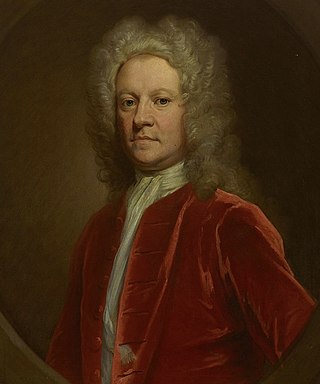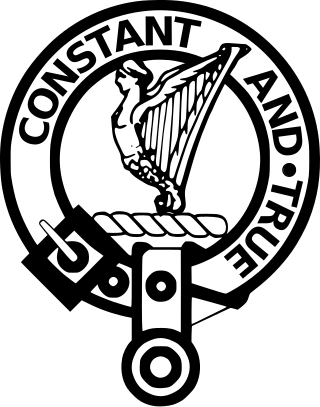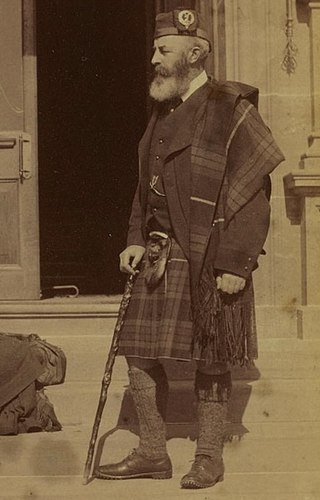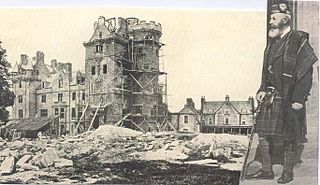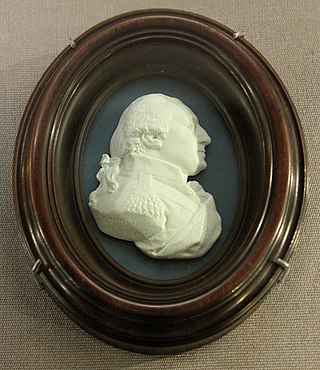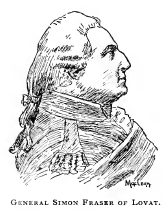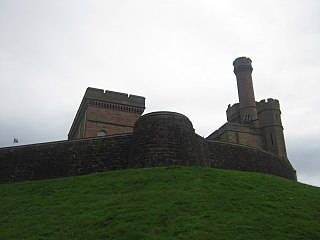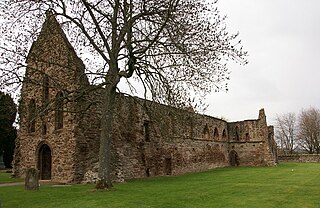| Lord Lovat | |
|---|---|
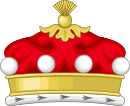 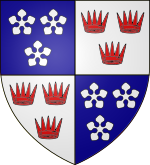 Quarterly, 1st & 4th: Azure three fraises Argent; 2nd & 3rd: Argent three antique crowns Gules. | |
| Creation date | 1458 |
| Created by | James III |
| Peerage | Peerage of Scotland |
| First holder | Hugh Fraser, 1st Lord Lovat |
| Present holder | Simon Fraser, 16th Lord Lovat |
| Heir presumptive | Hon. Jack Fraser, Master of Lovat |
| Subsidiary titles | Baron Lovat |
| Seat(s) | Beaufort Lodge Balblair House [1] |
| Former seat(s) | Beaufort Castle |
| Motto | Je suis prest (I am ready) |


Lord Lovat (Scottish Gaelic : Mac Shimidh) [2] is a title of the rank Lord of Parliament in the Peerage of Scotland. It was created in 1458 for Hugh Fraser by summoning him to the Scottish Parliament as Lord Fraser of Lovat, although the holder is referred to simply as Lord Lovat. It was a separate title from the Scottish feudal lordship of Lovat, already held by the highland Frasers. In 1837 they were created a third title, Baron Lovat, of Lovat in the County of Inverness, in the Peerage of the United Kingdom. The holder is separately and independently the Chief of the highland Clan Fraser of Lovat.
Contents
- Clan Fraser of Lovat
- Lairds of Lovat
- According to John Anderson and Alexander Mackenzie
- According to James Balfour Paul
- According to the modern Clan Fraser of Lovat
- Lords Fraser of Lovat (1458); Barons Lovat of Lovat (1837)
- Arms
- References
- External links
The first Lord Lovat was one of the hostages for James I of Scotland on his return to Scotland in 1424, and in 1431 he was appointed high sheriff of the county of Inverness. The second Lord Lovat, Thomas, held the office of Justiciary of the North in the reign of James IV of Scotland, and died 21 October 1524.
The title descended in a direct line for nine sequential generations from 1458 until the death of the ninth Lord in 1696. He was succeeded by his great-uncle, the tenth Lord. In 1697 the latter's son, Simon Fraser, 11th Lord Lovat, known as Simon "the Fox", kidnapped and forcibly married the late ninth Lord's widow, the former Lady Amelia Murray, only daughter of John Murray, 1st Marquess of Atholl. Lady Lovat's powerful family, the Murrays, were angered, and prosecuted Fraser, who fled the country. Fraser was convicted in absentia, attainted, and sentenced to death. Fraser supported the Government against the Jacobite rising of 1715 and was rewarded by being pardoned for his crimes. In 1730, he won litigation to confirm his title of Lord Lovat. In 1745 Lord Lovat participated in the Jacobite rising of 1745 (the ‘45) against the Crown and was sentenced to death. He was beheaded on 9 April 1747, aged 80, on Tower Hill in London, the last man to be executed in this manner. His titles were forfeit. Fraser had been created Duke of Fraser, Marquess of Beaufort, Earl of Stratherrick and Upper Tarf, Viscount of the Aird and Strathglass and Lord Lovat and Beaulieu in the Jacobite Peerage of Scotland by James Francis Edward Stuart (titular King James III of England and VIII of Scotland) in 1740.
His eldest son and namesake General Simon Fraser of Lovat became a general in the British Army. He obtained a full pardon but was not restored to the title. His younger brother Archibald Campbell Fraser was a colonel in the Army and would have succeeded but for the attainder. On his death in 1815 the title was claimed by his kinsman Thomas Fraser, a descendant of Thomas Fraser, second son of the fourth Lord. In 1837 he was created Baron Lovat, of Lovat in the County of Inverness, in the Peerage of the United Kingdom. The attainder of the eleventh Lord was reversed in 1854, and Thomas Fraser became the twelfth Lord Lovat. He was succeeded by his son, the thirteenth Lord, who served as Lord Lieutenant of Inverness. His eldest son, the fourteenth Lord, was a soldier and politician and notably held office as Under-Secretary of State for Dominion Affairs from 1926 to 1927. He was succeeded by his eldest son, the fifteenth Lord. He was a prominent soldier and distinguished himself during the Second World War. As of 2017 [update] the titles are held by his grandson, the sixteenth Lord, who succeeded in 1994.
The Conservative politician Sir Hugh Fraser was the younger son of the fourteenth Lord. Another member of the family was Sir Ian Fraser, Chairman of Rolls-Royce Motors. He was the son of Hon. Alastair Thomas Joseph Fraser, younger son of the thirteenth Lord.
The family seats are Beaufort Lodge and Balblair House, near Beauly, Inverness-shire.



